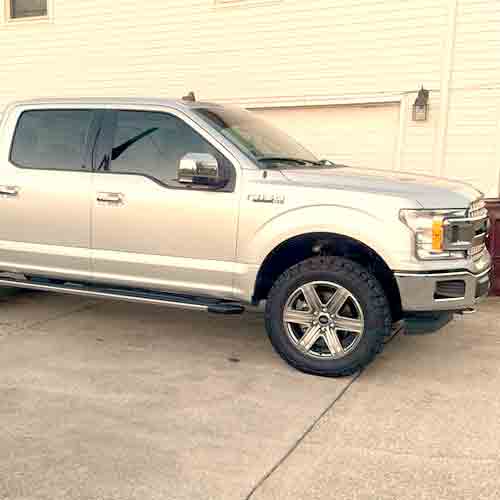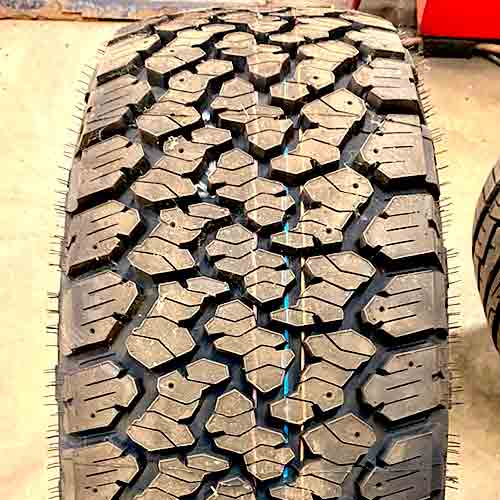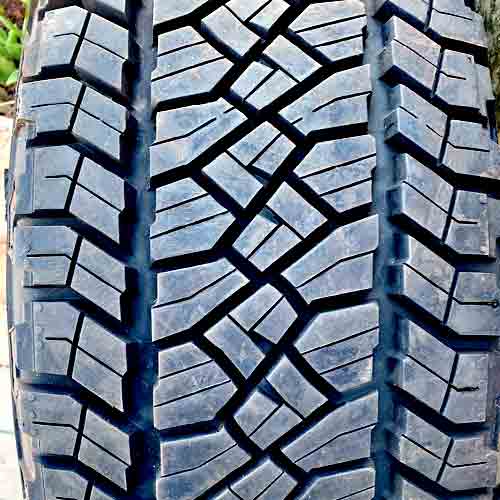Both the General Grabber APT and the Grabber ATX are all-terrain tires, offering impressive on/off road performance. But which one gets the nod for better on-road manners, and which one comes out on top, off-road? Let’s find out!

Having thoroughly studied and analyzed these tires, I can tell you that the General Grabber APT is a more on-road oriented tire, that’s why you get superior dry traction with it, as well as fuel economy, and on-road comfort (in terms of noise). Though still the tire can use some wet traction, and that’s where Grabber ATX comes in, which is also better on snow, and other types of off-road terrains, including mud.
Table of Contents
Sizes Specs
The General Grabber ATX (review), offers 14 to 20 inches rims, and they come with following specs.
- They have available speed ratings in Q, R, S and T
- Load range : SL, XL, C, D and E
- Tread depth: 14 to 16/32″
- Weight range: 28 lbs to 75 lbs
- Warranty: 60k miles
On the other side, the General Grabber APT (review) gives you 16 to 22 inches, where sizes come with:
- Speed ratings: R, S, T and H
- Load ratings: SL, XL, C and E
- Weight range: 28 to 58 lbs
- Tread depth: 13 to 16/32″
- Ratings: 3PMSF and M+S
- Warranty: 60k miles
Design
Starting with the bigger brother of the Grabber family, the Grabber A/TX.

So this tire give you more spaced up lugs overall, with 3 ribs in the middle creating 4 longitudinal channels, (see if you can picture them).
With this vertical alignment of placed lugs on all these ribs, the tire makes a stable connection with the road while moving directionally, so you get good enough braking distances and acceleration times.
And since these lugs also create an wrapping design forming interlocking grooves, you also get off-road traction with that as well.
Similarly, the sipes these lugs carry have dual functions too, they open all they down to the base, so where they offer wet traction on pavements, they get to flex and chew off-road especially on rocky surfaces.
And as these interlinked grooves connect with the outer wider circumferential channels and the lateral gaps of the shoulders, you also get dirt/mud traction as well.
Speaking of which, the shoulder lugs also help a lot in this, as they carry mud scoops on the outskirts, with their staggered shoulder design. And on rocks, the slanted sidewall lugs provide additional footprint with lowered air pressure.
So basically General Grabber A/TX kept all these terrains in mind while designing this tire.
Though things are better off, on smooth pavements with Grabber APT. Let me explain how, by considering its tread.

So the tread design of this tire features a clear-cut middle section divided by wider circumferential grooves made by shoulder lugs, as you can see.
This middle section basically consist of 3 ribs, which although seem to be aligned laterally, they also make (slanted) longitudinal grooves within as well.
So they get to provide a web of grooves running in all directions, allowing for self cleaning abilities, though with closed up design and foundational supports, the tread gets to do better on highways instead of rugged terrains.
Same goes for shoulders, they are although equipped with mud scoops, with their staggered outer edges, these lugs are still very packed up together and that provide less off-road grip, and better traction on highways.
Fuel And Tread
Being a less aggressive tire off the two, the General Grabber APT offers a lighter weighing construction, and compacted lugs arrangement, so naturally you get superior fuel economy here.
The General Grabber ATX on the other hand, comes not only with greater weight, but also a relatively open design. So here, each of its lugs rub off the surface with greater friction, promoting rolling resistance.
Though that does not mean, its tread wears off faster as well.
The Grabber ATX in fact offers the best tread wear resistance in the market (currently, compared to other similar aggressive A/T tires), that’s why I added this tire for it, in my list of top all time, all-terrain tires. See here: https://tiredriver.com/best-all-terrain-tires/
Moreover, that’s also the reason why both tires have similar 60k miles treadwear warranty, even though General ATX features a more aggressive design.
Side Note: The Grabber APT comes with a UTQG of 520 AB whereas the Grabber ATX gives you 620 AB (showing it’s better, even by the company’s ratings).
Winter Traction
The General Grabber ATX is a great tire for snowy terrains as well. The tire’s softer (in comparison) tread compound, is more thermal adaptive, and keeps its biting edges flexible
So with that, it gets to be more effective in trapping the snow particles in it’s hook shaped grooves, and making snow to snow contact with it.
And for ice, you get stud-able lugs, which also tells, how focused is this tire for snowy terrains.
On the other hand, the General Grabber APT is also pretty great and comes with 3 peak mountain snowflake rating (just like the ATX), the tire only performs better on lighter terrains, with it’s smaller groove mouth.
Highway Traction
An all-terrain tire‘s dry performance is influenced by 2 main factors, grip, and handling. Let’s take a look at both of them.
Dry Grip
Dry or directional grip signify the tire’s ability to maintain traction on a “straight path”. But why is that?
Well, because when moving on highways, (directioanlly), the center portion of the tire’s tread get to bear the most weight on it. That’s the reason why this grip gets calculated through measurements of braking distances and acceleration times.
And so it makes sense why the General Grabber APT with larger footprint availability (to meet with the road), renders superior grip in comparison.
The Grabber ATX on the other side, lacks with it’s inconsistent rubber to road contact, as the tire makes larger lateral tread voids.
Dry Handling
Tire’s handling depends on shoulder lugs, as weight moves towards edges as the tire corners. And here the same story goes for General Grabber ATX. The tire with larger tread voids (having bold stone ejectors), creates more interruptions in the overall rubber to road contact.
And with it’s greater weight, these lugs get to flex more, causing the tire to under and over steer.
The Grabber APT on the other side offers stiffer composition alongside of it’s packed up lugs arrangement, both of these provide amazing steering response, which results in superior handling times. This makes this tire better daily driver off the two (given things stay dry most of the time).
Wet Traction
To maintain wet traction, it is essential to have efficient water removal from the tire’s contact patch. This enables better grip and reduces the risk of hydroplaning. The two main components here. Let me start with the grip.
Wet Grip
On wet pavements, tires need sipes, which can flex to wipe water away. These are basically slits in the tread which contract/expand, sucking water particles in, allowing tread to grab the cleared off ground.
Although both tires have ample of these sipes, the General Grabber ATX still provides superior results, as it’s tread is more self cleaning, and it’s full depth sipes are more pliable to bend and create bite over wet ground.
In other words, its sipes aren’t restricted, and they are able to easily distort the lugs. Whereas on Grabber APT, the lugs are too packed up, and they don’t allow the sipes to be as flexible, which reduces it’s water wiping abilities drastically.
Hydroplaning
Hydroplaning is simply floating of a tire on water. So to avoid that, water needs to leave out as soon as possible, (mostly through the grooves). Though there’s a limit of how fast the water expels out, and it depends on the speed of the rolling tire.
In other words, risk of hydroplaning increases with higher speeds, that’s why it gets measured with “float speeds”, which tells how fast a tire can go over water without floating.
Out of both tires, the General Grabber APT although offers wide enough circumferential grooves, it still not as efficient in channeling water out sideways, so it lacks in curved float speeds.
The Grabber ATX on the other side, features much better interlinked tread voids structure capable of cleaning water out form multiple directions. So overall it’s better in this performance area.
On-Road Noise
The sound associated with tires is generated by air movement, primarily through the grooves on the shoulders. Air enters in, and hits the walls of the tread generating unwanted noise.
That’s why with a balder tread pattern, the General Grabber ATX gets to be louder in comparison.
The Grabber APT on the other side, has a lot more packed up shoulder lugs and so it kills the noise at the source (by not letting air in, the first place).
Moreover, the little air that still manages to comes in, producing noise, is better dealt with it’s superior pitch sequencing technology. Which creates different tones at different parts of the tread, and cancel out each other to dampen overall in-groove resonance.
For Your Info: The Grabber APT comes in the list of top quietest all-terrain tires.
On-Road Vibrations
Where General Grabber ATX lacks in generating a silent enough ride, it sure gives you a better performance in other half of comfort, with its superior bumps absorption capabilities.
Besides having a softer compound, the tire has a dedicated layer (just underneath the rubber), whose task is to dampen the vibrations of the road.
The Grabber APT on the other side, can not dampen the road irregularities as efficiently in comparison, mainly due to it’s stiffer rubber composition.
Durability
Durability is a necessary characteristic for off-road tires that must perform in tough conditions. To meet this requirement, although both of these tires are given similar internal built, the General Grabber ATX still gets to have an upper hand, with it’s greater tread depth, and more durable cut resistant rubber with Kevlar reinforcements.
The Grabber APT on the other side, although has the same 2 layers of polyamide under 2 steel belts and 2 nylon cap plies, it’s missing with proper sidewall lugs, and its rubber isn’t that chip resistant, comparatively.
Mud Traction
Simply put, the balder the tire, the better it gets for mud traction. That’s why out of both, the General Grabber ATX gets to have an upper hand.
The Grabber APT on the other side, features a more crowded arrangement of its blocks, and although they still get to make interlinking grooves connecting with the wider circumferential channels, it’s still not enough to outperform the ATX with it’s aggressive mud scoops and shoulder voids having bold dirt ejectors in between.
Side Note: I talked about all-terrain tires on mud here. You may want to check this out.
Rock Climbing Abilities
For effective climb on rocky terrains, you have to ensure, tires won’t slip especially sideways (which can overturn your ride in worst case scenario even).
That’s why Grabber ATX does better here.
The tire’s interlocking structure grips at multiple angles, and as all lugs get to split open, thanks to full depth sipes, that grip further gets aided.
On the flip side, it’s little brother, with smaller groove mouth isn’t able to bite into the rocky surface with as much force.
Moreover, it’s also missing sidewall lugs, so lowering air pressure can’t provide as good of a results as seen on ATX.
Sand Performance
Sand requires floating, as on this soft terrain, its pretty easy to sink in, which is the worst for the traction.
That’s why the General Grabber ATX with bulky sidewall lugs yield superior traction relatively. They get to spread out more enhancing the tire’s overall footprint, and with it’s contact patch with the sand.
The Grabber APT on the other side, isn’t able to provide the same level of traction, even though you get a considerably lighter structure here.
Key Takeaway
With a more aggressive tread design, you get a superior traction off-road on Grabber ATX. That’s out there. But what’s still surprising to see, is that tire also does relatively better on snow, and wet roads, as well as tread wear department.
On the other side the General Grabber APT features superior dry grip performance, fuel efficiency, and comfort performance (in terms of noise generation).